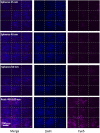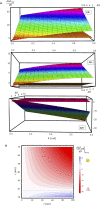The aspect ratio effect on the cytotoxicity of inert nano-particles flips depending on particle thickness, and is one of the reasons for the literature inconsistency
- PMID: 36540111
- PMCID: PMC9724609
- DOI: 10.1039/d2na00453d
The aspect ratio effect on the cytotoxicity of inert nano-particles flips depending on particle thickness, and is one of the reasons for the literature inconsistency
Abstract
The interaction of inert nano-particles with cells has significant effect on the potential cytotoxicity of the particles. The role of particle aspect ratio in the interaction with cells was largely studied in the literature; however non consistent conclusions were obtained. In the present study a detailed physical model is presented as well as a set of experimental work and a scan of literature data. The aim was to investigate the role of particle size and aspect ratio in cell uptake, and to examine possible sources of the literature inconsistency. Cells which provide the first line of contact with particles in the human body were incubated with seven types of particles. These included spherical and rod gold nanoparticles, as well as larger spherical polystyrene particles in various sizes. We stress that in order to achieve comparative insight careful attention needs to be given to the experimental conditions and to the data analysis. Furthermore, our physical model shows that conclusions regarding the role of aspect ratio in NP uptake largely depend on the radius of the particles. The aspect ratio cannot be regarded as a sole geometrical parameter which determines the interaction of inert nano-particles with cells. When discussing particles larger than 10 nm (for which passive diffusion is irrelevant), the effect of the aspect ratio flips depending on the particle thickness. For particles thicker than ∼35 nm, the longer they are the more toxic they would be, however this trend opposes for thinner NPs, where larger aspect ratio results in reduced uptake and toxicity. Therefore, rod non-functionalized particles whose thickness is between 15 and 30 nm, and are relatively long, are expected to be the safest, with minimal cytotoxicity.
This journal is © The Royal Society of Chemistry.
Conflict of interest statement
There are no conflicts to declare.
Figures








Similar articles
-
Impact of agglomeration state of nano- and submicron sized gold particles on pulmonary inflammation.Part Fibre Toxicol. 2010 Dec 2;7(1):37. doi: 10.1186/1743-8977-7-37. Part Fibre Toxicol. 2010. PMID: 21126342 Free PMC article.
-
Interaction of nano-TiO2 with lysozyme: insights into the enzyme toxicity of nanosized particles.Environ Sci Pollut Res Int. 2010 Mar;17(3):798-806. doi: 10.1007/s11356-009-0153-1. Epub 2009 Apr 24. Environ Sci Pollut Res Int. 2010. PMID: 19390888
-
A systematic electron microscopic study on the uptake of barium sulphate nano-, submicro-, microparticles by bone marrow-derived phagocytosing cells.Acta Biomater. 2018 Oct 15;80:352-363. doi: 10.1016/j.actbio.2018.09.026. Epub 2018 Sep 18. Acta Biomater. 2018. PMID: 30240952
-
Grey goo on the skin? Nanotechnology, cosmetic and sunscreen safety.Crit Rev Toxicol. 2007 Mar;37(3):251-77. doi: 10.1080/10408440601177780. Crit Rev Toxicol. 2007. PMID: 17453934 Review.
-
Air pollution, ultrafine and nanoparticle toxicology: cellular and molecular interactions.IEEE Trans Nanobioscience. 2007 Dec;6(4):331-40. doi: 10.1109/tnb.2007.909005. IEEE Trans Nanobioscience. 2007. PMID: 18217626 Review.
Cited by
-
Elongated Particles Show a Preferential Uptake in Invasive Cancer Cells.Nanomaterials (Basel). 2024 Nov 25;14(23):1891. doi: 10.3390/nano14231891. Nanomaterials (Basel). 2024. PMID: 39683280 Free PMC article.
-
High Recognition of Isomer-Stabilized Gold Nanoparticles through Matrix Imprinting.ACS Appl Mater Interfaces. 2023 Jul 12;15(27):32687-32696. doi: 10.1021/acsami.3c04311. Epub 2023 Jun 26. ACS Appl Mater Interfaces. 2023. PMID: 37358329 Free PMC article.
References
-
- Carnovale C. Bryant G. Shukla R. Bansal V. Identifying Trends in Gold Nanoparticle Toxicity and Uptake: Size, Shape, Capping Ligand, and Biological Corona. ACS Omega. 2019;4:242–256. doi: 10.1021/acsomega.8b03227. - DOI
LinkOut - more resources
Full Text Sources
Miscellaneous

